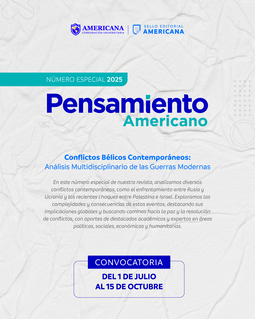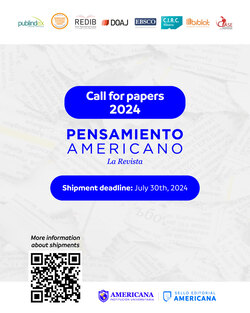La percepción ciudadana sobre la sostenibilidad del patrimonio mundial. El caso del centro histórico de Santa Ana de Cuenca
DOI:
https://doi.org/10.21803/pensam.v12i24.312Palabras clave:
Ciudadanía; gestión; metodología participativa; Patrimonio Mundial; UNESCOResumen
La incorporación del modelo sostenible en la gestión del Patrimonio Mundial, implica un enfoque participativo en la identificación, protección, conservación, presentación y transmisión de los valores universales excepcionales para las generaciones futuras. La ciudadanía, como actor social relevante, aporta una percepción del patrimonio que informa sobre cuestiones clave para lograr una gestión sostenible del mismo. La carencia de metodologías para comprender la relación entre la sociedad y el patrimonio desde el enfoque sostenible, sin embargo, supone una limitación para la participación de la ciudadanía en la gestión patrimonial. Este articulo proporciona evidencia empírica sobre el nivel de sostenibilidad que existe en el centro histórico Patrimonio Mundial de Cuenca (Ecuador), desde la percepción ciudadana. Los resultados estadísticos revelan que la sostenibilidad del patrimonio depende de una reputación que se construye en torno a múltiples fenómenos interconectados que determinan unos patrones actitudinales positivos o negativos. El articulo contribuye así? a la comprensión de la relación entre ciudadana y patrimonio, haciendo hincapié? en los aspectos que deben ser trabajados metodológicamente para lograr una gestión sostenible del centro histórico de Cuenca.
Descargas
Referencias
Agapito, D., Mendes, J. & Valle, P. (2013). Exploring the conceptualization of the sensory dimension of tourist experiences. Journal of Destination Marketing & Management, 2(2), 62-73.
Auclair, E. & Fairclough, G. (2015). Theory and practice in heritage and sustainability: Between past and future: Routledge.
Axelsson, R., Angelstam, P., Degerman, E., Teitelbaum, S., Andersson, K., Elbakidze, M. & Drotz, M. K. (2013). Social and cultural sustainability: Criteria, indicators, verifier variables for measurement and maps for visualization to support planning. Ambio, 42(2), 215-228.
Bakri, A. F., Ibrahim, N., Ahmad, S. S. & Zaman, N. Q. (2015). Public Perception on the Cultural Significance of Heritage Buildings in Kuala Lumpur. Procedia-Social and Behavioral Sciences, 202, 294-302.
Bandarin, F. & Van Oers, R. (2014). Reconnecting the city: the historic urban landscape approach and the future of urban heritage: John Wiley & Sons.
Bitner, M. J. (1992). Servicescapes: the impact of physical surroundings on customers and employees. Journal of Marketing, 56(2), 57–71
Bossel, H. (1999). Indicators for sustainable development: theory, method, applications.
Borowiecki, K. J., Forbes, N. & Fresa, A. (2016). Cultural heritage in a changing world: Springer.
Brown, J. and Meczynski, M. (2009), “Complexcities’: locational choices of creative knowledge workers”, Built Environment, Vol. 35 No. 2, pp. 238-52 (Chapain, C., Collinge, C., Lee, P. and Musterd, S. (Guest Eds), Hall, P. and Banister, D. (Eds), ¿Can We Plan the Creative Knowledge City? Alexandrine Press, Oxon).
Brundtland, C. (1987). World commission on environment and development. Our common future.
Buchel, S. & Frantzeskaki, N. (2015). Citizens’ voice: A case study about perceived ecosystem services by urban park users in Rotterdam, the Netherlands. Ecosystem Services, 12, 169-177.
Carbone, L. P. & Haeckel, S. H. (1994). Engineering customer experiences. Marketing Management, 3(3), 8–19.
Carrión, F. (2008). Centro histórico: la polisemia del espacio público. Centro-h (2), 89-96.
Cervelló-Royo, R., Garrido-Yserte, R. & del Río, B. (2012). An urban regeneration model in heritage areas in search of sustainable urban development and internal cohesion. Journal of Cultural Heritage Management and Sustainable Development, 2(1), 44- 61.
Chi, C. G. Q., Cai, R. & Li, Y. (2017). Factors influencing residents’ subjective well-being at World Heritage Sites. Tourism Management, 63, 209-222.
Condon, P. M. (2012). Design charrettes for sustainable communities: Island Press.
Costello, A.B. y Osborne, J. W. (2005). Best Practices in Exploratory Factor Analysis: Four Recommendations for Getting the Most from Your Analysis. Practical Assessment, Research & Evaluation Vol. 10 (7) disponible en: http://pareonline.net/genpare.asp?wh=0&abt=10
Cowell, B. (2004). Why heritage counts: researching the historic environment. Cultural Trends, 13(4), 23-39.
Cronbach, L. J. (1951). Coefficient alpha and the internal structure of tests. psychometrika, 16(3), 297-334.
Dessein, J., Soini, K., Fairclough, G., y Horlings, L. G. (2015). Culture in, for and As Sustainable Development; Conclusions from the COST Action IS1007 Investigating Cultural Sustainability: University of Jyväs- kylä.
Díaz, P. & Fernández, P. (2001). Determinación del tamaño muestral para calcular la significación del coeficiente de correlación lineal. Metodología de la Investigación, 1(6).
Edinburgh Council, Edinburgh World Heritage Site, His- toric Environment Scotland, Steering Group. (2011). The Old and New Towns of Edinburgh WHS management plan 2011-2016. Recuperado de: https://planningedinburgh.files.wordpress.com/2016/07/onte-consultation-july-2016-text-version.pdf
GAD Cuenca. (1998) Propuesta de inscripción del Centro Histórico de Cuenca Ecuador en la lista de patrimonio mundial.
GAD Cuenca. (2015a) Plan de Desarrollo y Ordenamien- to Territorial PDOT
GAD Cuenca. (2015b) Plan de movilidad y espacios públicos PMEP
Galla, A. (2012). World Heritage: benefits beyond borders: Cambridge University Press.
Grimwade, G., y Carter, B. (2000). Managing small heritage sites with interpretation and community involvement. International Journal of Heritage Studies, 6(1), 33-48.
Hair J, A., Tatham, R. & Black, W. (2006). Multivariate Data Analysis. NJ: Pearson/Prentice Hall, Inc.
Harrison, R. (2013). Heritage: critical approaches: Routledge.
Harrison, R. (2015). Beyond “Natural” and “Cultural” Heri- tage: Toward an Ontological Politics of Heritage in the Age of Anthropocene. Heritage & Society, 8(1), 24-42. doi: 10.1179/2159032X15Z.00000000036
Hinton, P. R., McMurray, I., y Brownlow, C. (2004). SPSS explained. Routledge
Iacono, V. L., & Brown, D. H. K. (2016). Beyond Binarism: Exploring a Model of Living Cultural Heritage for Dance. Dance Research, 34(1), 84-105.
INEC. (2010) VII Censo de Población y VI de Vivienda del Ecuador. Recuperado de: ? www.inec.go.cr/sites/ default/f iles/documentos/anuario... /reanuarioes- tad2010-02.pdf >
INEC. (2017) Conozcamos a Cuenca a través de sus cifras. Noviembre 1. Recuperado de: ? http://www.ecuadorencif ras.gob.ec/conozcamos-cuenca-a-traves-de-sus-cifras/ >
Jeon, M. M., Kang, M. M. & Desmarais, E. (2016). Residents’ perceived quality of life in a cultural-heritage tourism destination. Applied Research in Quality of Life, 11(1), 105-123.
Jimura, T. (2011). The impact of world heritage site de- signation on local communities--A case study of Ogimachi, Shirakawa-mura, Japan. Tourism Management, 32(2), 288-296.
Kim, J. & Mueller, C. W. (1994). Factor Analysis, Statistical Methods and Practical Issues En Lewis-Beck, M. S. (Ed.) (1994). Factor Analysis and Related Techniques. London: Sage Publications, 75-155
Landorf, C. (2009). Managing for sustainable tourism: a review of six cultural World Heritage Sites. Journal of Sustainable Tourism, 17(1), 53-70.
Landorf, C. (2011). Governance in historic urban environ- ments: A theoretical review. International Journal of Heritage and Sustainable Development, 1(1), 7-16.
Lawton, L. J. & Weaver, D. B. (2015). Using residents’ perceptions research to inform planning and management for sustainable tourism: A study of the Gold Coast Schoolies Week, a contentious tourism event. Journal of Sustainable Tourism, 23(5), 660-682.
Levi, D. & Kocher, S. (2013). Perception of sacredness at heritage religious sites. Environment and Behavior, 45(7), 912-930.
Licciardi, G. & Amirtahmasebi, R. (2012). The economics of uniqueness: investing in historic city cores and cultural heritage assets for sustainable development: Washington, United States: World Bank Publications.
López-Roldán, P. & Fachelli, S. (2015). Metodología de la investigación social cuantitativa. Bellaterra (Cerdanyola del Vallès): Dipòsit Digital de Documents, Universitat Autònoma de Barcelona.
Makuvaza, S. (Ed.). (2017). Aspects of Management Planning for Cultural World Heritage Sites: Principles, Approaches and Practices. Springer.
Mišeti?, A. & Ursi?, S. (2015). 4 Remembering cities.
Theory and Practice in Heritage and Sustainability: Between Past and Future, heritage reputation using citizen sensing. Habitat International, 45, 156-162.
Nicholas, L. N., Thapa, B. & Ko, Y. J. (2009). Residents Perspectives of a World Heritage Site: The Pitons Management Area, St. Lucia. Annals of Tourism Research, 36(3), 390-412. doi: http://dx.doi.org/10.1016/j.annals.2009.03.005
ONU. (1992). Conferencia sobre el Medio Ambiente y el Desarrollo (CNUMAD). Recuperado de: ?http://www.un.org/spanish/esa/sustdev/ agenda21/riode- claration.htm >
ONU. (2015). Transformar nuestro mundo: la Agenda 2030 para el Desarrollo Sostenible A/70/l.1 (25 de septiembre). Recuperado de: ? https://unctad.org/meetings/es/SessionalDocuments/ares70d1_es.pdf
Pickard, R. (2013). Management of historic centres. London, England: Taylor & Francis.
Rachao, S., Matos, O. & Silva, P. (2014). Community involvement and management organisations’ interaction in a UNESCO classified area: issues from Porto World Heritage Site.
Ramo, B. (2012). Merry Go Round; proposte per un manisfesto non troppo paradossale. Casabella, Italian review of architecture (No. 812, April. Milan, Mondadori), 56-73.
Rasoolimanesh, S. M., Roldán, J. L., Jaafar, M. & Ramayah, T. (2017). Factors influencing residents’ perceptions toward tourism development: Differences across rural and urban world heritage sites. Journal of Travel Research, 56(6), 760-775.
Rasoolimanesh, S. M. & Jaafar, M. (2017). Sustainable tourism development and residents’ perceptions of World Heritage Site destinations. Asia Pacific Journal of Tourism Research, 22(1), 34-48.
Ripp, M. & Rodwell, D. (2018). Governance in UNESCO World Heritage Sites: Reframing the Role of Management Plans as a Tool to Improve Community Engagement. In S. Makuvaza (Ed.), Aspects of Management Planning for Cultural World Heritage Sites: Principles, Approaches, and Practices (pp. 241-253). Cham: Springer International Publishing.
Molina Neira, B. A. (2018). La incorporación de la cultura y el patrimonio en el desarrollo sostenible: desafíos y posibilidades. Revista humanidades, 8(1).
Monteiro, V., Painho, M. & Vaz, E. (2015). Is heritage really important? A theoretical framework for Rodwell, D. (2007). Conservation: Background. Conservation and Sustainability in Historic Cities, 1-22.
Rotondo, F., Selicato, F., Marin, V. & Galdeano, J. L. (2016).Cultural Territorial Systems: Landscape and Cultural Heritage as a Key to Sustainable and Local Development in Eastern Europe: Springer.
Smith, L. (2006). Uses of heritage: Routledge.
Soini, K. & Dessein, J. (2016). Culture-Sustainability Relation: Towards a Conceptual Framework. Sustainability, 8(2), 167.
Tajani, F. & Morano, P. (2016). A Systematic Analysis of Benefits and Costs of Projects for the Valorization of Cultural Heritage. In Cultural Territorial Systems (pp. 107-118). Springer, Cham.
Terzi?, A., Jovi?i?, A. & Simeunovi?-Baji?, N. (2014). Community Role in Heritage Management and Sustainable Turism Development: Case Study of the Danube Region Serbia. Transylvanian Review of Administrative Sciences, 10(SI), 183-201.
The Heritage Council of Victoria (2014) The community perceptions of heritage, octubre. Recuperado de:
?https://heritagecouncil.vic.gov.au/wp-content/ uploads/2016/07/Community-Perceptions-of-Heritage.pdf. >
Throsby, D. (2017). Culturally sustainable development: theoretical concept or practical policy instrument?. International Journal of Cultural Policy, 23(2), 133- 147.
Tira, M. (2016). Pedestrian Accessibility of Historical Centers: A Key Determinant of Development. In Cultural Territorial Systems (pp. 351-361). Springer, Cham.
Trimarchi, M. (2004). Regulation, integration and sustainability in the cultural sector. International Journal of Heritage Studies, 10(5), 401-415.
Tuan, T. H. & Navrud, S. (2008). Capturing the benefits of preserving cultural heritage. Journal of cultural heritage, 9(3), 326-337.
Tweed, C. & Sutherland, M. (2007). Built cultural heritage and sustainable urban development. Landscape and Urban Planning, 83(1), 62-69. doi: http://dx.doi.org/10.1016/j.landurbplan.2007.05.008
UNESCO. (2014). Indicadores UNESCO de cultura para el desarrollo: manual metodológico.
UNESCO. (2017). Operational Guidelines for the Implementation of the World Heritage Convention, WHC.17/01. Recuperado de: ? https://whc.unesco.org/en/guidelines/>
Van Oers, R. & Pereira Roders, A. (2012). Historic cities as a model of sustainability. Journal of Cultural Heritage Management and Sustainable Development, 2(1), 4-14.
Weiler, B. (2017). The future has other plans: planning holistically to conserve natural and cultural heritage.
Wu, S. R., Fan, P. & Chen, J. (2016). Incorporating culture into sustainable development: A cultural sustainability index framework for green buildings. Sustainable Development, 24(1), 64-76.
Descargas
Publicado
Versiones
- 2019-07-16 (3)
- 2016-07-19 (2)
- 2019-07-16 (1)
Número
Sección
Licencia
Derechos de autor 2019 Pensamiento Americano

Esta obra está bajo una licencia internacional Creative Commons Atribución-NoComercial-SinDerivadas 4.0.
Bajo las condiciones siguientes:
-
Reconocimiento — Debe reconocer adecuadamente la autoría, proporcionar un enlace a la licencia e indicar si se han realizado cambios<. Puede hacerlo de cualquier manera razonable, pero no de una manera que sugiera que tiene el apoyo del licenciador o lo recibe por el uso que hace.
-
NoComercial — No puede utilizar el material para una finalidad comercial.
-
SinObraDerivada — Si remezcla, transforma o crea a partir del material, no puede difundir el material modificado.
- No hay restricciones adicionales — No puede aplicar términos legales o medidas tecnológicas que legalmente restrinjan realizar aquello que la licencia permite.






